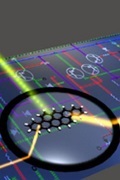24/05/2016
BGU researchers have presented a novel design technique for optical reversible nano-gates and circuits. It is a design that can be implemented in practice, and a crucial step towards the implementation of energy conserving computation.
One of the greatest challenges in computing is to reduce the energy consumption, not only for the sake of reducing the tremendous amount of electric power used by the computer-based industry (for example, Google, Amazon or Facebook) but also to enable computing devices to operate at a higher frequency without melting as a result of the extra heat. For example, cooling all of the world’s data centers accounts for 1.5% of total global electricity.
“These gates will form the basis of the next shift in technology giving us faster, more efficient computers and drastically reducing the need to cool proliferating data centers,” says Prof. Shlomi Dolev of the Department of Computer Science. Their proposal was published last month in Nature Communications.
A radical change in computer design may possibly lead to the crucial breakthrough needed for achieving more energy-efficient information processing. Prof. Dolev and his Ph.D. student Eyal Cohen, and Dr. Michael Rosenblit of the Nano-Fabrication Center of the Ilse Katz Institute for Nanoscale Science and Technology propose an implementable optical reversible computer that uses light instead of electricity for computing. Optics are already used in fiber optic communication. An optical computer would benefit from the speed of light and energy efficiency just as well. In just one example, it would avoid the need for converting energy traveling on fiber optic cables in the form of light back into electricity when it hits a circuit.
If their proposal is implemented, the three argue, a lot of wasted energy could be prevented while the cost of computing will be significantly reduced. The researchers are ready to begin work on implementing a prototype.
Reversible gates have been of interest since 1961 but have been considered technologically infeasible, until now. The researchers were surprised to discover a rigorous mathematics for describing, analyzing and implementing (in a simulator that predicts fabrication results) reversible gates and circuits.













